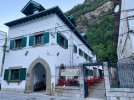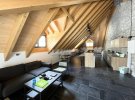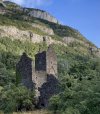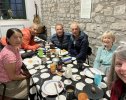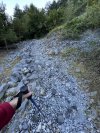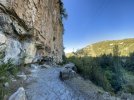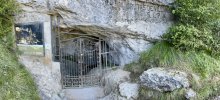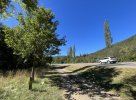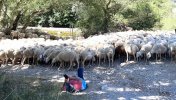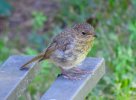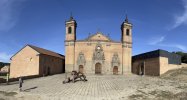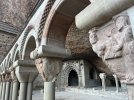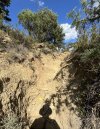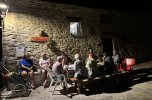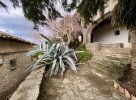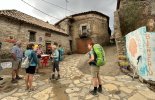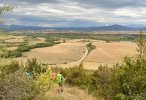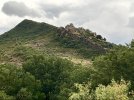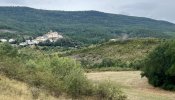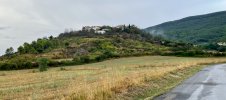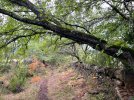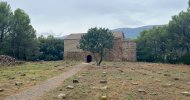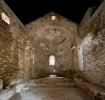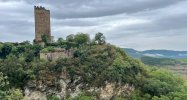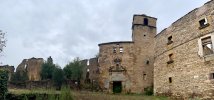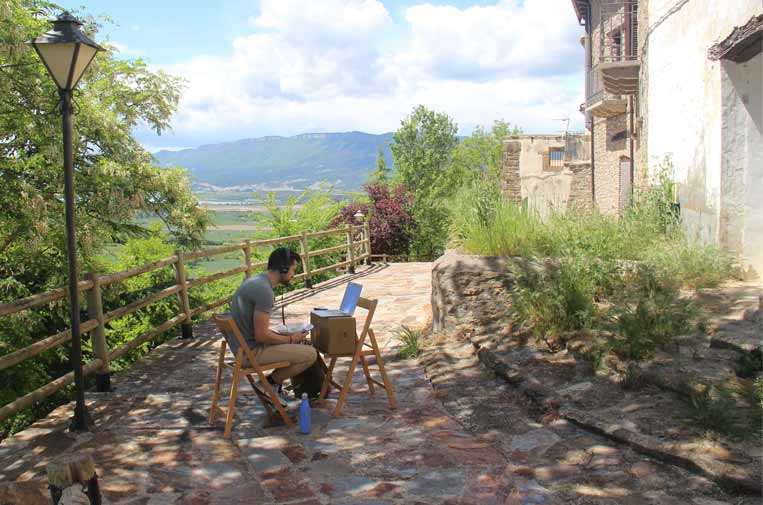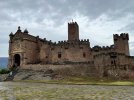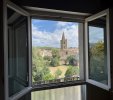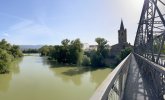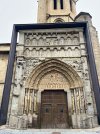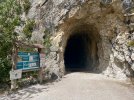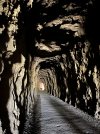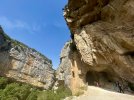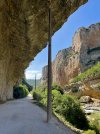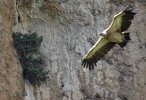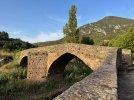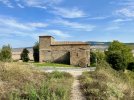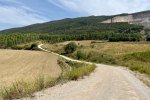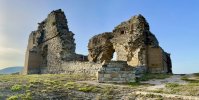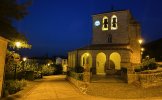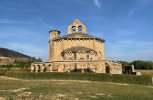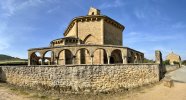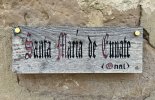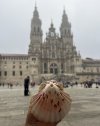- Time of past OR future Camino
- Most recent: Fall 2023 Aragonés, Frances
How I traveled to Candanchú (2 km from Somport) in one day.
From Madrid:
-10:35am Renfe Train from Atocha Rail Station, arrive 1:45pm Pamplona Iruna Rail Station.
-3:30pm La Burendesa Bus from Pamplona Bus Station, arrive 5:25pm Jaca Bus Station.
-7:30pm Mavaragon Bus from Jaca Bus
Station, arrive 8:10pm Candanchú. The driver dropped me off in front of the hotel where I was staying that night.
Day 1: (Wed Aug 30) Somport to Canfranc Pueblo
I had planned to walk the 2 km up the hill to Somport but was offered a ride from an employee at the hotel. I stopped in at the Aysa hostel in Somport to get the first stamp in my credential. The trail begins in front of the hostal.
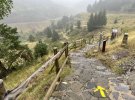
A heavily misty morning without the spectacular mountain views I’d been looking forward to! Still, it was beautiful and I was happy to finally be taking first steps on this camino, watching the mist drift, revealing bits of colour, trees and the contours of the slopes and ridge lines. The lovely trail winds down the slope above the Aragón river, sometimes very steep and eroded in places but staying sure-footed helps to keep it manageable. Grateful for my walking poles!
Just before Candanchú are the ruins of the 13th century hospital of Santa Christina, a hugely important place of refuge for pilgrims.
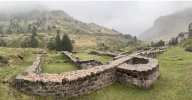
The trail ends at the road which winds around and away from Candanchú with dramatic mountain slopes on either side. On the right slope, above the river, I watched and listened to 4 shepherds and 3 dogs as they managed a massive flock of sheep.
Very soon, a yellow arrow led me off the road to the right and onto a dirt path which continued to run parallel with the road until the Santa Christina Bridge. I was following Gronze route info and was a bit confused at this point. The bridge that I assumed was the Santa Christina is on the road and crossing it would have you continue on the road.
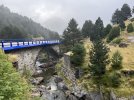
On the parallel dirt path I was following was a wooden bridge that once crossed, had me continue on an uphill path (noted by Gronze) which is what I did. I continued along the path climbing up a bit more and then along the slope, following yellow arrows and looking for the point where the path would descend to cross the national road (Gronze). Arrows stopped, I retraced my steps to the last arrow, looking down to the road and any indication of where the crossing should be. I finally saw a camino marker and arrow across the road but it took a while to find a place to descend and cross the road which led to the beginning of a long winding, sometimes steep and rocky descent through a lovely aromatic fir and pine forest.
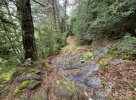
Every so often, I could hear sheep bells in the distance ahead. Evidence on the path led me to believe that they had descended this path not to long before me!
The path led to the national road again and a parallel dirt path for the final push into Canfranc Estación and the first views of the phenomenal restoration of the train station.

I don’t know why I thought it would be possible for a weary muddy shoed pilgrim to sit in their bar or cafe and enjoy a cafe von leche. Very quickly I saw it was clearly not possible. I could enter the lobby, have a look, take a photo in the centre and then exit either front or back. All other areas are roped off with signs stating “for guests only”. I can understand why - hundreds of curious people passing through the revolving doors under the watchful eye of a security guard. Directly across from the station is a wonderful cafe - Cafeteria El Andén. A great place for lunch!
Very quickly I saw it was clearly not possible. I could enter the lobby, have a look, take a photo in the centre and then exit either front or back. All other areas are roped off with signs stating “for guests only”. I can understand why - hundreds of curious people passing through the revolving doors under the watchful eye of a security guard. Directly across from the station is a wonderful cafe - Cafeteria El Andén. A great place for lunch!
Skies were clearing as I made my way out of town. I stopped at the new pilgrim office / info centre. Got a stamp and had a nice chat.
Very quickly along the extremely busy road road, you cross through a short tunnel and then descend steps to the left and on to a dirt path leading to the broken bridge over the Aragón. As I reached the bottom of the steps, 2 pilgrims coming toward me told me the bridge wasn’t passable. I told them there was a board placed for crossing the river. I had seen the notice in Gronze. It is confusing though. Arrows still lead to the bridge which is blocked off but there is no info about the alternative, There is a slope down to the river but the board can’t be seen immediately from the top.
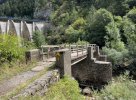
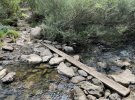
Once across the wonderful board bridge, the path continues all the way, mostly through a beech forrest, across another bridge, through more forest and into Canfranc Pueblo.


I made my way to the absolutely beautiful donativo Elias Valina Albergue de Peregrinos Canfranc and a very warm welcome from hospitaleras Vitoria and Therese.

From Madrid:
-10:35am Renfe Train from Atocha Rail Station, arrive 1:45pm Pamplona Iruna Rail Station.
-3:30pm La Burendesa Bus from Pamplona Bus Station, arrive 5:25pm Jaca Bus Station.
-7:30pm Mavaragon Bus from Jaca Bus
Station, arrive 8:10pm Candanchú. The driver dropped me off in front of the hotel where I was staying that night.
Day 1: (Wed Aug 30) Somport to Canfranc Pueblo
I had planned to walk the 2 km up the hill to Somport but was offered a ride from an employee at the hotel. I stopped in at the Aysa hostel in Somport to get the first stamp in my credential. The trail begins in front of the hostal.

A heavily misty morning without the spectacular mountain views I’d been looking forward to! Still, it was beautiful and I was happy to finally be taking first steps on this camino, watching the mist drift, revealing bits of colour, trees and the contours of the slopes and ridge lines. The lovely trail winds down the slope above the Aragón river, sometimes very steep and eroded in places but staying sure-footed helps to keep it manageable. Grateful for my walking poles!
Just before Candanchú are the ruins of the 13th century hospital of Santa Christina, a hugely important place of refuge for pilgrims.

The trail ends at the road which winds around and away from Candanchú with dramatic mountain slopes on either side. On the right slope, above the river, I watched and listened to 4 shepherds and 3 dogs as they managed a massive flock of sheep.
Very soon, a yellow arrow led me off the road to the right and onto a dirt path which continued to run parallel with the road until the Santa Christina Bridge. I was following Gronze route info and was a bit confused at this point. The bridge that I assumed was the Santa Christina is on the road and crossing it would have you continue on the road.

On the parallel dirt path I was following was a wooden bridge that once crossed, had me continue on an uphill path (noted by Gronze) which is what I did. I continued along the path climbing up a bit more and then along the slope, following yellow arrows and looking for the point where the path would descend to cross the national road (Gronze). Arrows stopped, I retraced my steps to the last arrow, looking down to the road and any indication of where the crossing should be. I finally saw a camino marker and arrow across the road but it took a while to find a place to descend and cross the road which led to the beginning of a long winding, sometimes steep and rocky descent through a lovely aromatic fir and pine forest.

Every so often, I could hear sheep bells in the distance ahead. Evidence on the path led me to believe that they had descended this path not to long before me!
The path led to the national road again and a parallel dirt path for the final push into Canfranc Estación and the first views of the phenomenal restoration of the train station.

I don’t know why I thought it would be possible for a weary muddy shoed pilgrim to sit in their bar or cafe and enjoy a cafe von leche.
Skies were clearing as I made my way out of town. I stopped at the new pilgrim office / info centre. Got a stamp and had a nice chat.
Very quickly along the extremely busy road road, you cross through a short tunnel and then descend steps to the left and on to a dirt path leading to the broken bridge over the Aragón. As I reached the bottom of the steps, 2 pilgrims coming toward me told me the bridge wasn’t passable. I told them there was a board placed for crossing the river. I had seen the notice in Gronze. It is confusing though. Arrows still lead to the bridge which is blocked off but there is no info about the alternative, There is a slope down to the river but the board can’t be seen immediately from the top.


Once across the wonderful board bridge, the path continues all the way, mostly through a beech forrest, across another bridge, through more forest and into Canfranc Pueblo.


I made my way to the absolutely beautiful donativo Elias Valina Albergue de Peregrinos Canfranc and a very warm welcome from hospitaleras Vitoria and Therese.

Last edited:






